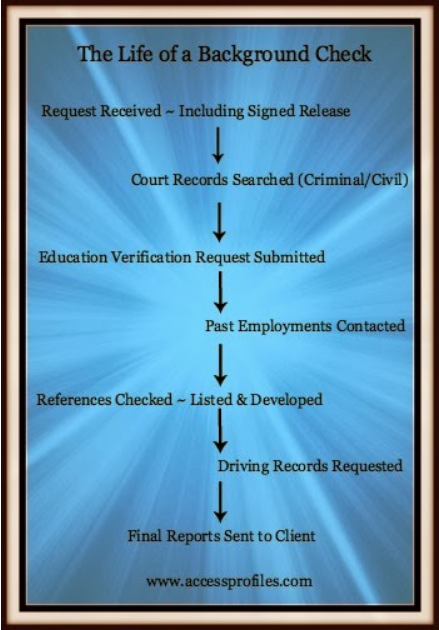The Life Of a Background Check: Start To Finish, What You Should Know

Do you know what happens during an employment background check?
If your answer is no, you are not alone.
Here I share with you a step by step guide to the Life of a Background Check.
You will see what I do and why during each step of the process.
Read on…….
My first step – getting the signed release.
I require each of my clients to obtain a signed release from their applicants. This ensures that the subject understands that a background check is being done and gives me access to information where a signed release is required (many education, employment, and sometimes criminal records among others).
The release contains the subject’s identifying information (name, any previous names used, date of birth, social security number).
It also shows addresses for the past 7 years, institution and date of highest diploma/degree earned, and driver’s license information.
If my client wants past employments or references verified, I would also request a copy of the applicant’s resume.
Upon sending me this information, my client would also inform me of what I need to verify. Depending on the job description, it can be as little as verifying local criminal court information or as detailed as a full background check.
Giving my clients this flexibility allows them to choose only what they really need among my services. In this way, I can accommodate businesses of all sizes.
My next step is to start verifying the information my client requested.
Since all background checks involve some type of criminal record investigation, I start there.
I use actual court records during criminal record checks.
This may involve a combination of logging into a court’s online database and actual physical inspection of court records.
This is not an “instant” process. Most records can be obtained within 24 to 48 hours, but that is not always the case.
My search focuses on felonies first, then lower graded offenses if necessary. Convictions are of the utmost importance, especially if the record involves crimes that would create an unsafe work environment for my client.
The importance of being accurate requires diligence in investigating these records.
My goal is to make sure that any record found matches with the identifying information of the subject. The ideal situation is to match more than one of these identifiers. This helps ensure the record, in fact, belongs to the subject.
The verification of civil court records is very similar.
However, these records rarely contain more than the name and address of each party. Therefore it is important to have the past addresses of your subject when searching these records.
If requested, I would then concentrate on verifying education, employments, and references.
Education verifications can involve anything from high school diplomas, college degrees, and even certificates or professional licenses.
Many times this is where having a signed release is crucial. I am often required to send in a copy of a signed release before I am able to obtain any information.
What I am looking for is corroboration that the information listed by the applicant matches what is supplied by my source. I always prefer to go directly to the institution where the degree, diploma, or license was issued. However, many are now using a “clearinghouse” instead of their own registrar office to run verifications.
When conducting an employment verification, I am looking to match dates and title of employment with those listed on the subject’s resume.
I also check “reason for leaving” and whether the applicant is “eligible for rehire.”
Most times this is the only information that a company will verify (although it is sometimes possible to get salary information), even with a signed release. At times it will only be dates and title. By asking about “reason for leaving” and rehire, I am often able to get a better glimpse into the nature of the employment.
It is at this stage that delays can occur. Many times I have to call a company multiple times before I am able to speak with someone who can answer my verification questions.
Some companies no longer handle verifications in-house and they contract this duty out to another company (much like with education verifications).
While this can speed up the process, there are often additional fees involved in this type of search.
For references, my policy is to contact those listed by the applicant and develop one or two of my own.
This is an important step. References listed by the applicant are likely to only give a positive report (although you may be surprised!). Because I am often playing “phone tag” with these individuals, this step can take some time.
If my client has requested a driving record, I would have also submitted this request.
Often a signed release is required. I contact the department of motor vehicles (or a state’s equivalent) to obtain this information.
Unless the applicant is being given a company car, or they are required to drive a company truck, many clients skip this step. However, if they do, it is important that I check whether the subject’s license is valid, they have any necessary commercial licenses, and they don’t have excessive driving violations.

Life of a Background Check Chart
While every company is different, it is my policy to write and send my reports as completed. In this way, my client is getting their requested information in as timely a manner as possible.
After completing all the reports, my work is done.
My client now has all the information they need to make an informed hiring decision. As I have discussed in previous blog articles, “how” they can safely use this information in the employment process is another matter.
The key to all these steps is accuracy.
For me and my clients, speed is not the first consideration. Taking the time to verify information from the best possible sources is best for both my clients and the applicant.
This is the “life” of a typical Background Check. Following these steps is key to helping you achieve your ultimate goal – a great, new hire!
To learn more about this, check out my book Hire Train Retain: How to Get the Right People in the Right Roles Doing the Right Things , our free downloads or sign up for a demo of the XP3 Talent System.



